We’re true Swifties at Rockfish Wildlife Sanctuary!
Now, we don’t mean fans of Taylor Swift (though, admittedly, some of our staff members certainly are). We mean fans of the original swift: the Chimney Swift! 👏
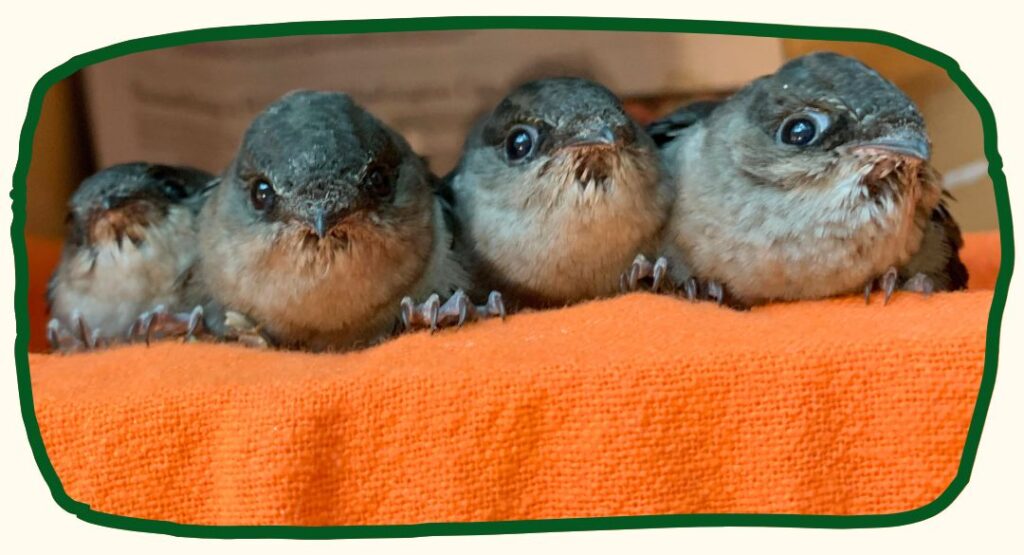
We currently have over 20 of these charming, punk rock dinosaurs birds in care at RWS. Like they do every year, these loud baby birds have stolen our hearts.
But what makes them so special, and how can you (yes, you!) help their species thrive?
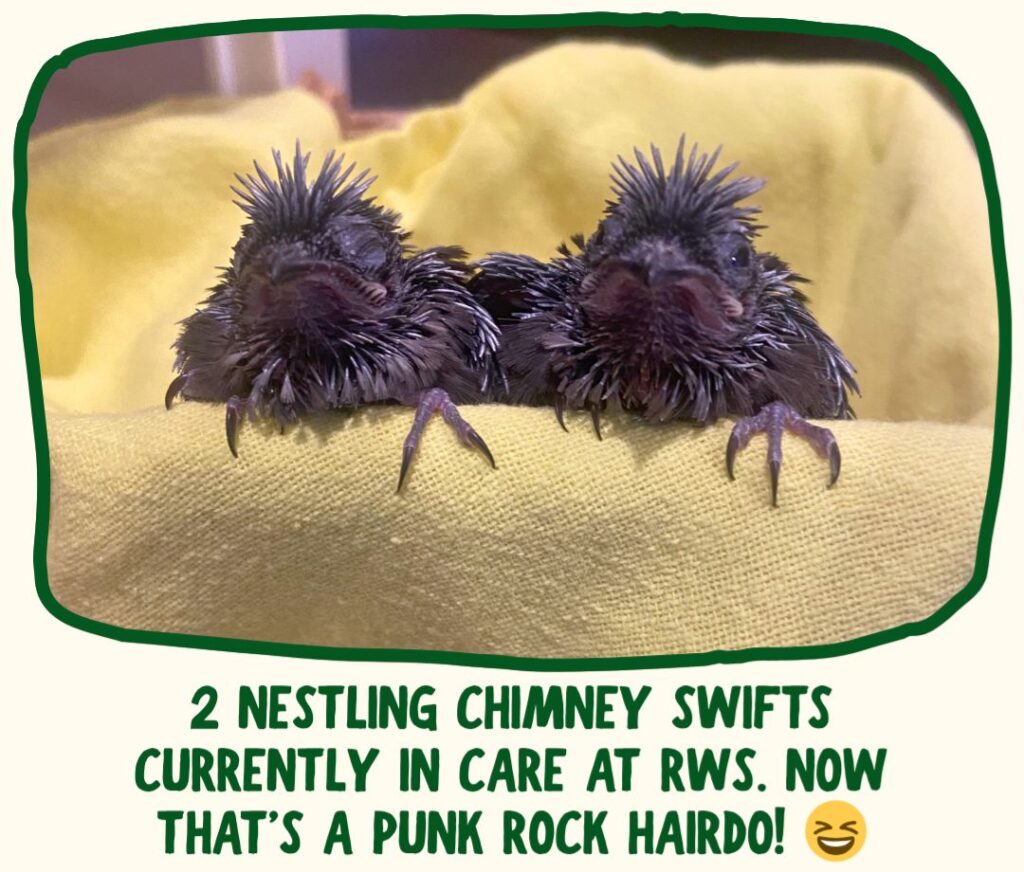
Chimney Swifts: A Natural History
Chimney Swifts (Chaetura pelagica) get their common name from their tendency to roost in chimneys, but that’s not what they evolved to do. Before European colonialism in the eastern Americas, swifts roosted in caves, dead trees, and old woodpecker holes. As colonists cleared forests and altered the landscape, those natural roosting sites dwindled. These adaptable little birds made the best of a bad situation and moved right into the new chimneys popping up throughout colonial settlements. 🏠
Speaking of evolution…the Chimney Swift is a bit of an outlier here in Virginia! They are our only native swift on the East Coast, though they’re often mistaken for members of the swallow family. However, they are not closely related to swallows, which are perching birds (passerines). Instead, their nearest “cousin” in Virginia are our native hummingbirds. Both swifts and hummingbirds are members of the taxonomic order Apodiformes, meaning “footless.” 👣
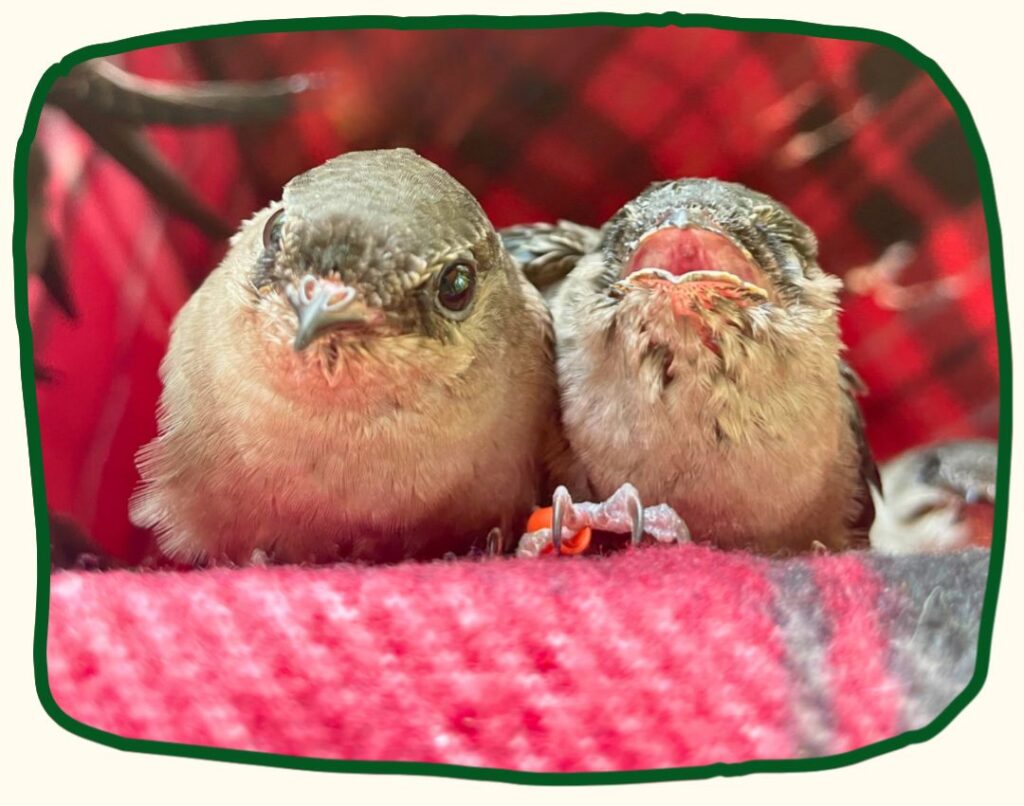
Aerial Insectivores
Chimney Swifts and hummingbirds don’t actually lack feet, though. They just don’t use their feet much! Chimney Swifts are aerial insectivores. They eat flying insects and live the majority of their lives “on the wing,” meaning in flight. They soar high in the sky, far above the treeline and buildings. In fact, swifts can fly as high as 3,000 feet. 🛫
As Chimney Swifts flit about, they grab itty bitty flying insects out of the air and gobble them up without missing a wingbeat. These speed demons can fly as fast as 60 miles per hour in pursuit of their prey, and they can easily cover a cumulative distance of over 500 miles per day while foraging. Yes, per day! 😮💨
Like bats, Chimney Swifts help immensely with pest control. 🦟 A mated pair of swifts can eat over 12,000 insects each day. They chow down on mosquitoes, gnats, flies, termites, and other little flying bugs. If you’re not a fan of any of the above, you should be a fan of Chimney Swifts!
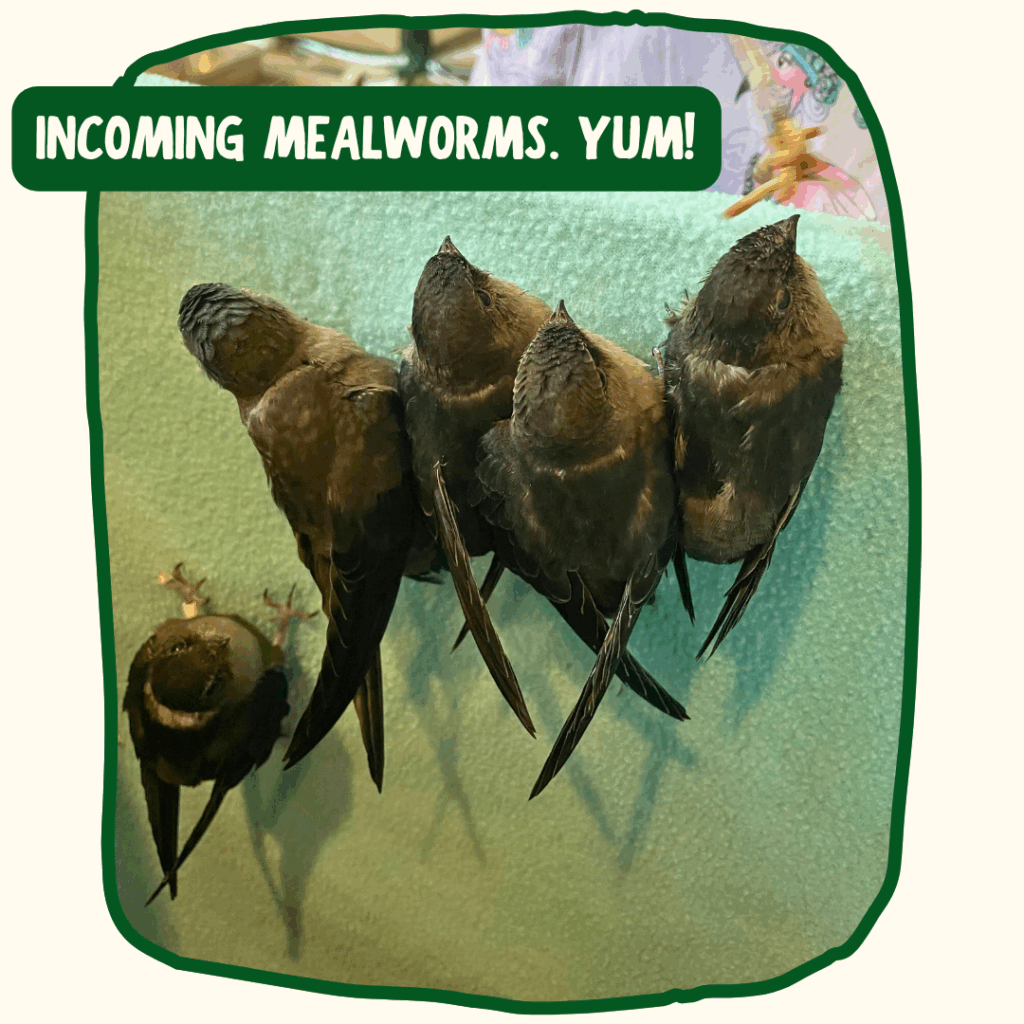
Chimney Swifts further flex their flight skills with an impressive fall migration to South America. 🏖️ They cover roughly 6,000 miles round trip every year through this long-haul journey. They travel in large flocks, sometimes thousands at a time, stopping only to roost together each night in caves, snags (dead trees), or, of course, chimneys.
Just Hanging Out!
Roosting is when those cool feet finally get put to good use! These charming sooty-gray birds have pamprodactyl toes, meaning all four of their toes point forward. They can move their outer digits down for better grip, but they cannot perch like your typical robins and chickadees do. Instead, they cling vertically to surfaces like bark or brick, with their glossy black wings tucked neatly behind them. Swifts are our only native bird with pamprodactyl feet! Here’s a quick visual guide to terrestrial bird feet, for the morphology nerds out there. ⬇️😉
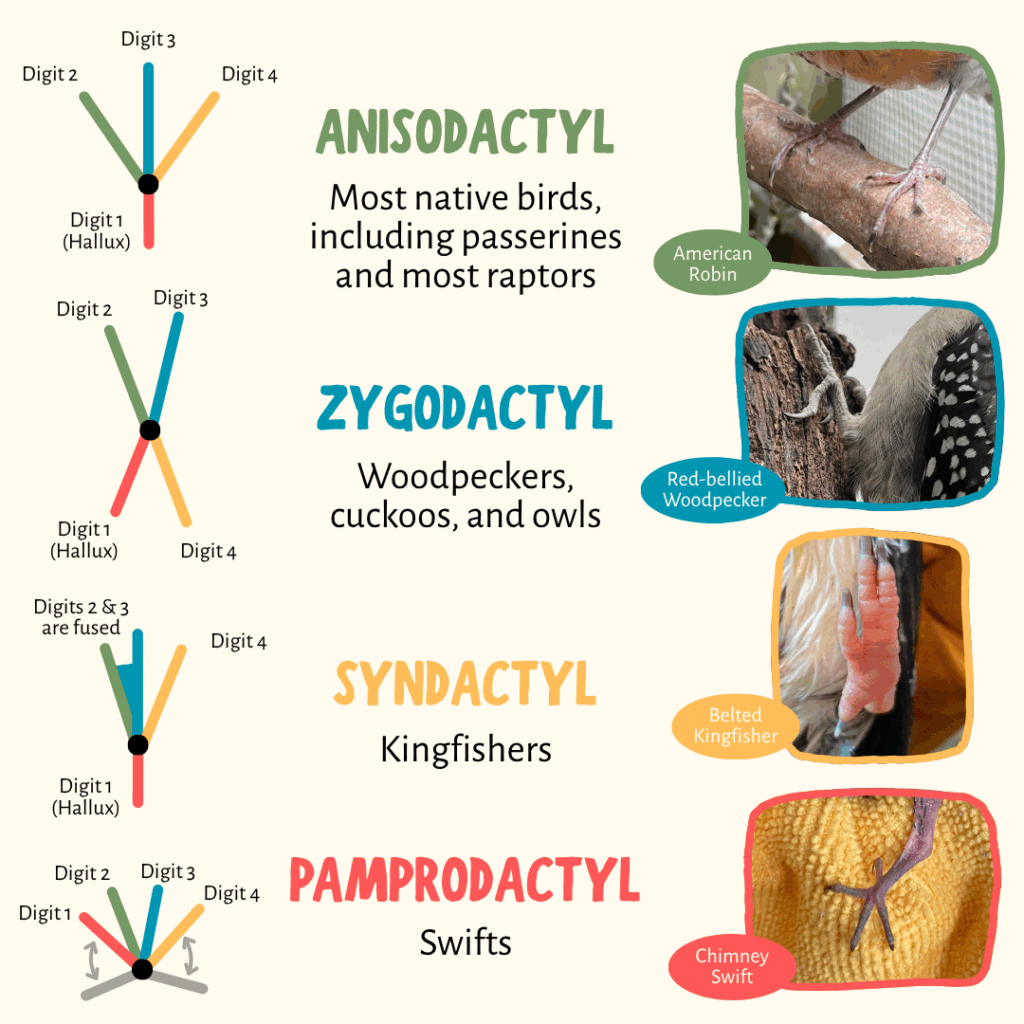
Another neat feature adapting Chimney Swifts well for vertical roosting is their tail. Their Latin genus, Chaetura, means “spine-tailed” and is an apt description for each of the bird’s tail feathers. By ending in a sharp point, the tail helps the swift cling more safely to its roosting surface. Think of them like built-in climbing shoes, adding a bit more grip to their ability to quite literally hang out. 🧗♀️

Raising Baby Swifts
Just like sleeping, nesting is a vertical affair for these unique birds. Chimney Swifts mate and reproduce along the eastern United States after a winter spent gorging on insects in South America. Mated pairs usually return to the same nesting location, year after year, and are largely monogamous. Some mate for life! 🥹
As they prepare to welcome a new brood, the male and female gather small sticks mid-flight and bring them back to their nesting location. The devoted parents-to-be then use their thick, glue-like saliva to hold the twigs together, securely sticking the nest against the side of the structure without needing to rest it on a branch like a typical bird nest. 🪹 Aren’t you glad IKEA instructions don’t mention saliva as a necessary tool?!
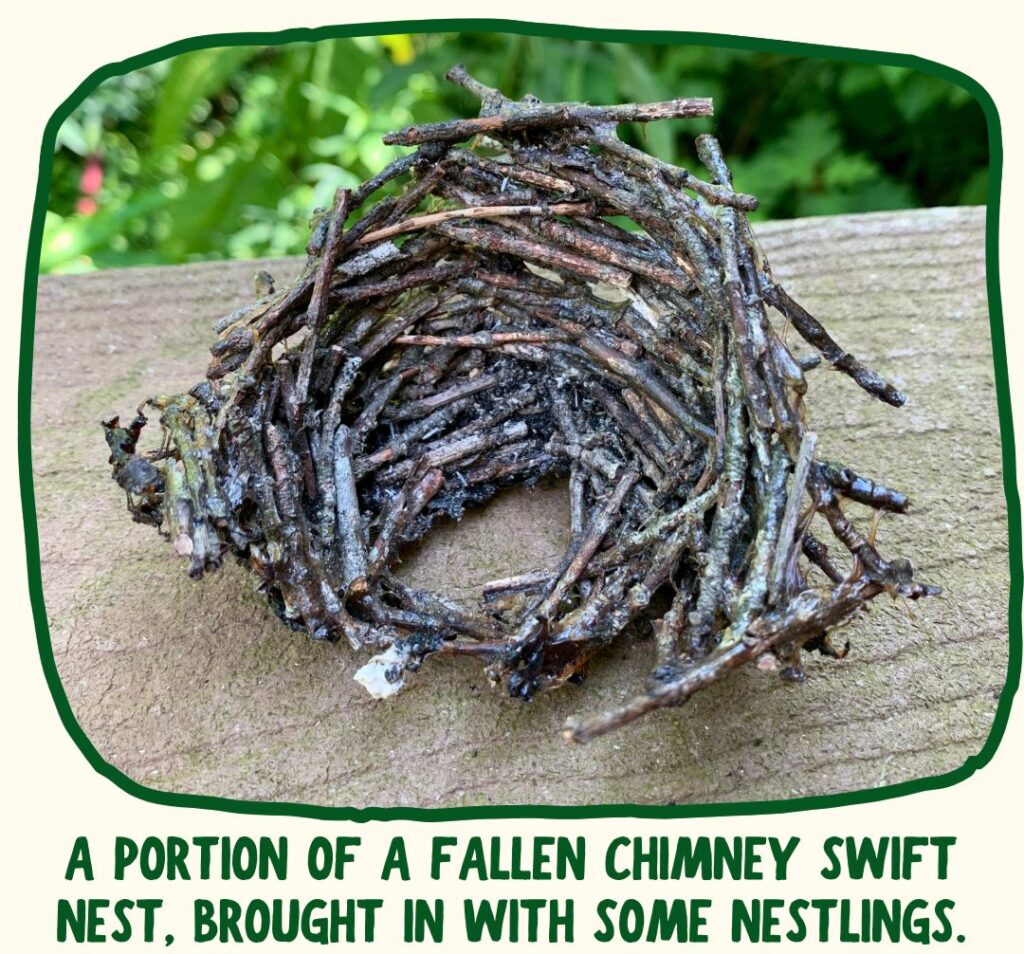
Once their nest is complete, it’s time to welcome the next generation of punk rock birds into the world! 🎸 Come mid-June, Mom lays 3–5 eggs and incubates them for just about three weeks before they hatch. Mom and Dad are extremely attentive parents, ensuring their chittering babies are fed all day long. They might even have an unmated swift or one of last year’s offspring help care for this year’s nestlings.
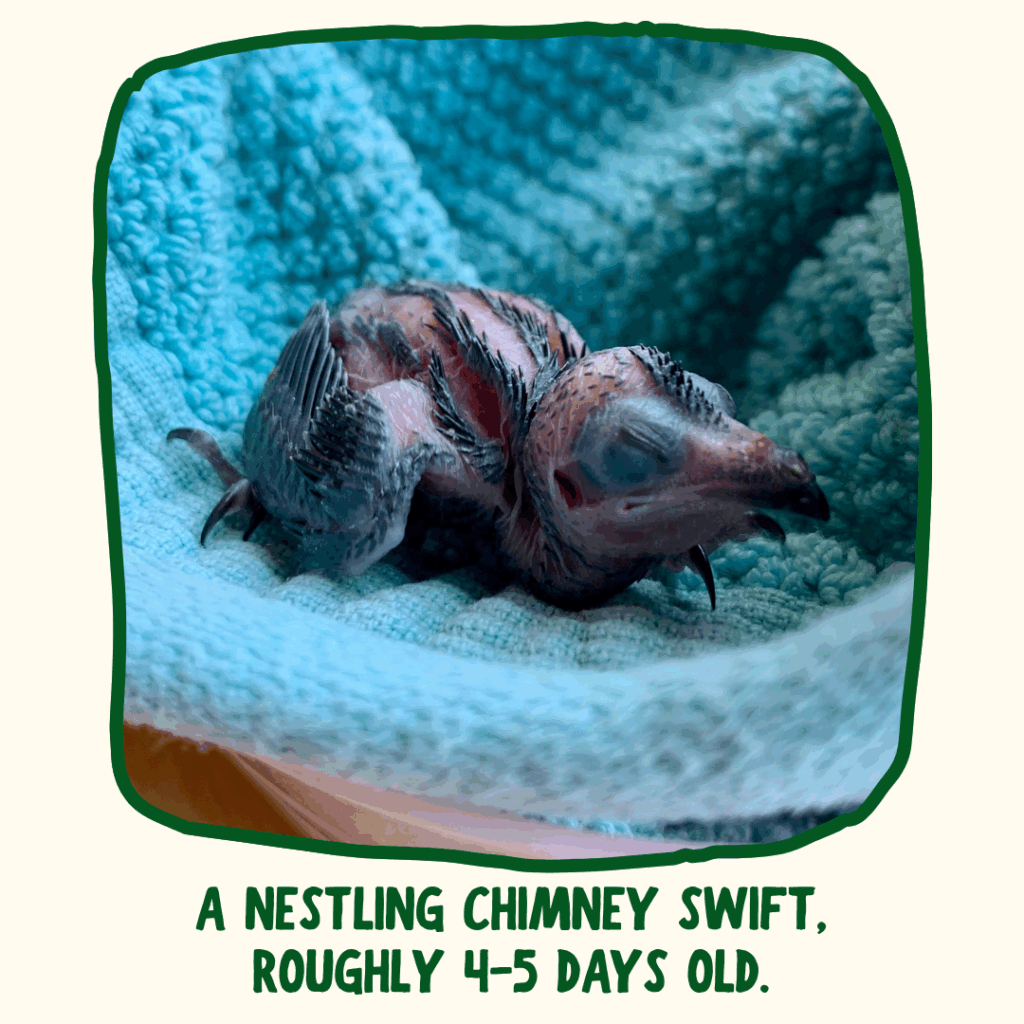
This nesting period is when humans most often encounter (or simply hear) Chimney Swifts. The babies are surprisingly noisy for their small size, but fear not—they usually fledge after just three weeks and will be on their merry way. Enjoy the “feed me!” calls from our current cohort of swifts at the Sanctuary:
Chimney Swift Rescue & Rehab
All of these swifts came to RWS after falling down chimneys, though, so accidents do happen with those nests! The good news is that re-nesting baby swifts is possible with a little bit of legwork, as long as the baby does not have any clear injuries requiring care. Grab a small, sturdy basket to make a new “nest” out of and either rope it down into or stick it back up the chimney, depending on what works best for your chimney’s build. Check out a visual below. ⬇️
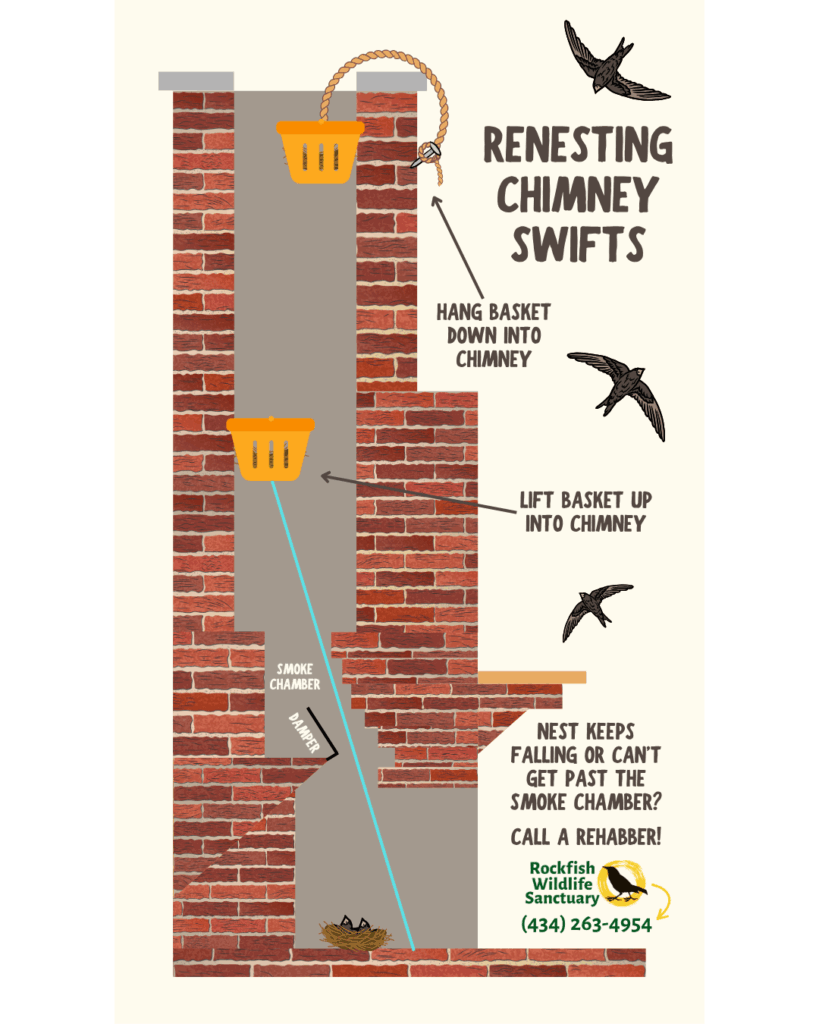
If re-nesting isn’t possible or if it fails, call RWS. Once in rehabilitative care, nestling Chimney Swifts at the Sanctuary receive our very best! Not only are they fed every 30 minutes, but we even have our own “chimneys” in our nursery and flight enclosures—not to mention the flight enclosure itself, which was specifically designed for Chimney Swift care. Its octagonal shape encourages sustained, circular flight, ensuring these long-haul migrants build up the flight stamina necessary to join a migrating flock after release. 💪 The wooden chimney inside the flight enclosure provides a safe, naturalistic spot for swifts to rest in as they add more laps to their training regimens.
Assuming all continues to go to plan, we expect to be able to release our first cohort of orphaned Chimney Swift patients this weekend! 🥳
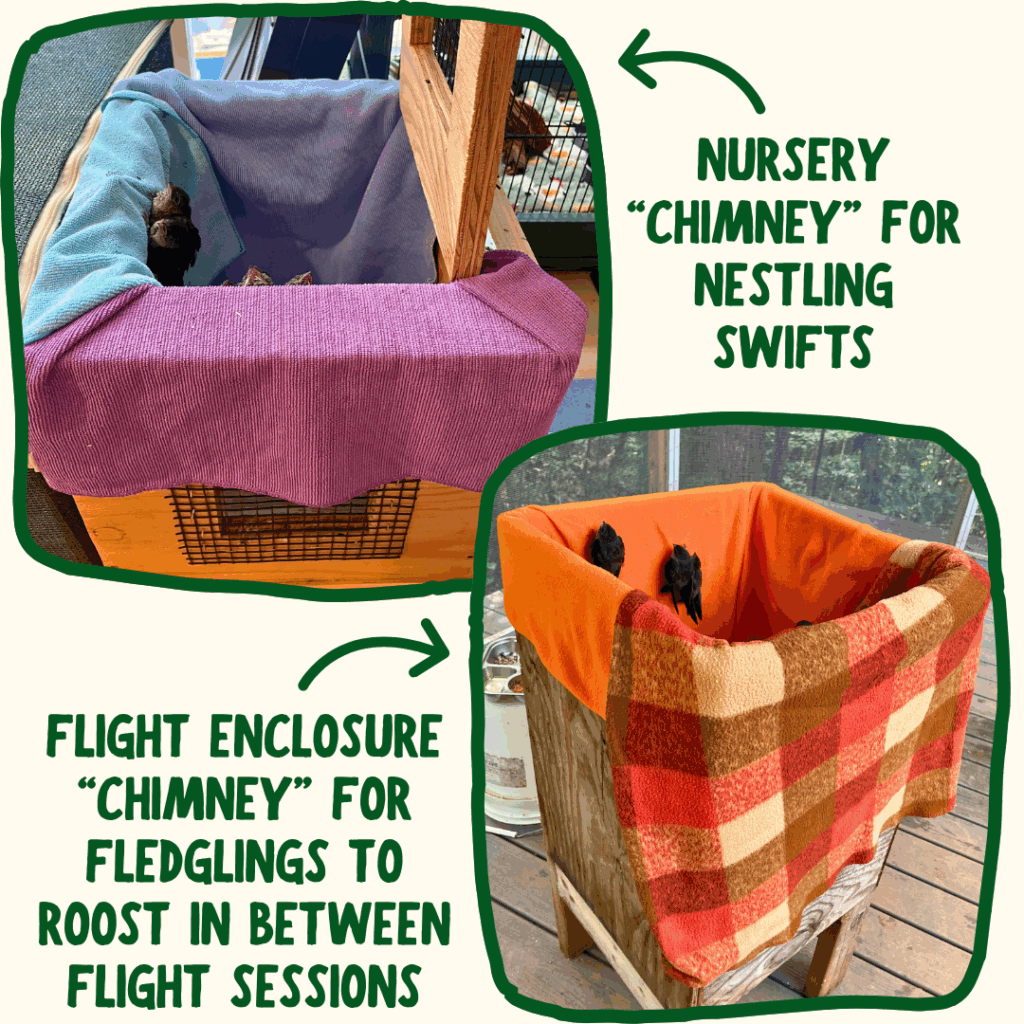
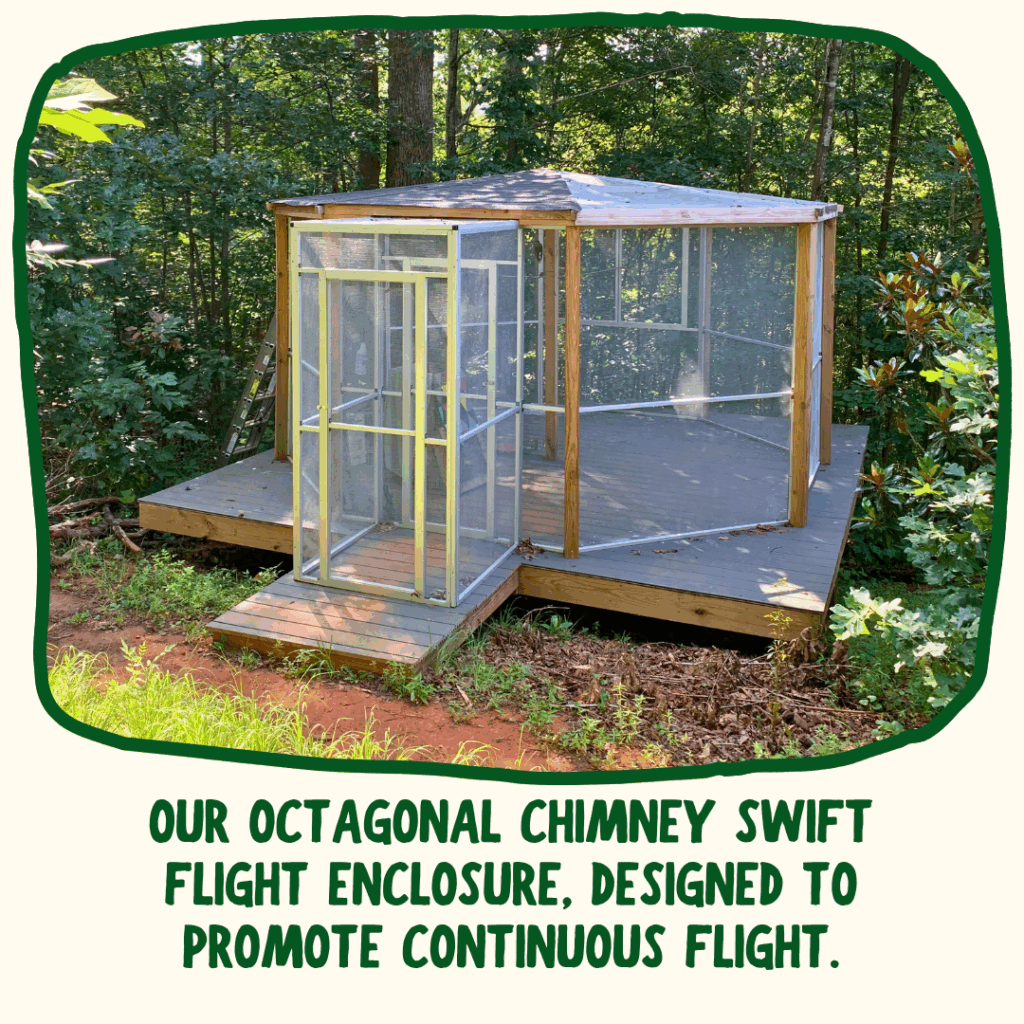
Chimney Swift Conservation
We take our role in helping all wildlife seriously, but we are honored to help Chimney Swifts in particular because their species faces alarmingly steep declines. 📉 These birds are classified as Vulnerable by the IUCN Red List, and the species has lost up to 74% of its population since 1966 according to 2023’s North American Breeding Bird Survey.
However, the 2025 State of the Birds Report released this past March elevated the Chimney Swift to an Orange Alert on their Tipping Point Species scale due to accelerated population declines in just the past decade. Though the factors contributing to these losses are complex, it boils down to continued habitat loss, especially of old-growth forests, and traditional chimney structures falling out of fashion and into disrepair. ☹️
With these declines in mind, every single Chimney Swift we care for and release is a tangible conservation win.
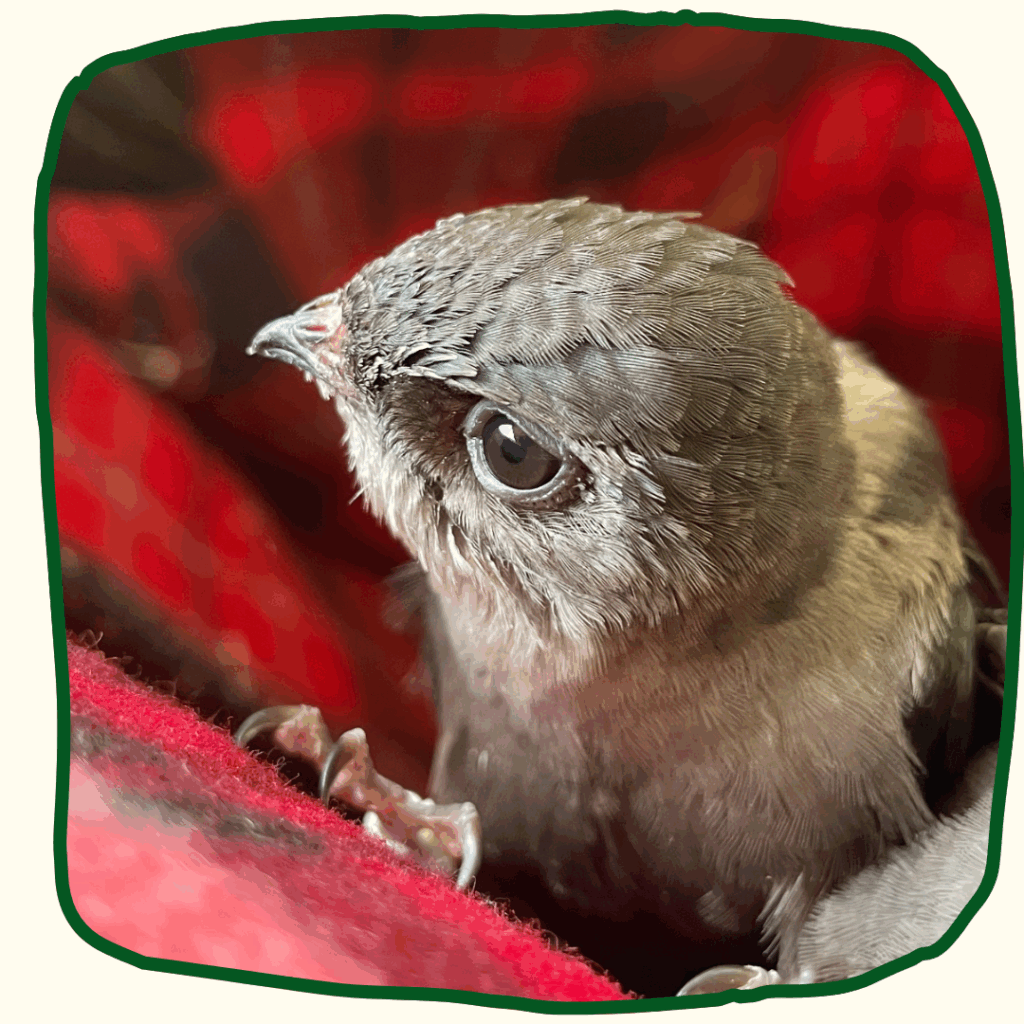
How to Help Chimney Swifts
That said, there are simple ways you can support Chimney Swifts from home, too! ⬇️
If you have a chimney:
- Have the chimney cleaned annually to get rid of potentially toxic smoke buildup, but do so in mid–March once wood fire season is over but nesting season hasn’t begun.
- Don’t cap brick chimneys, if possible! Consider uncapping your chimney if it’s already capped. Chimney Swifts do not cause structural damage, and every clean, uncapped chimney represents hope for this species in decline.
- Cap steel-lined chimneys to prevent wildlife from getting stuck.
If you don’t have a chimney and still want to help:
- Stop using insecticides. Insect decline is a huge factor in bird losses overall, not just for Chimney Swifts.
- Invest in some window decals to prevent birds from colliding during migration. Find the right anti-collision solution for you on the Bird Collision Prevention Alliance’s website.
Better yet? Make your own Chimney Swift tower! 🛠️

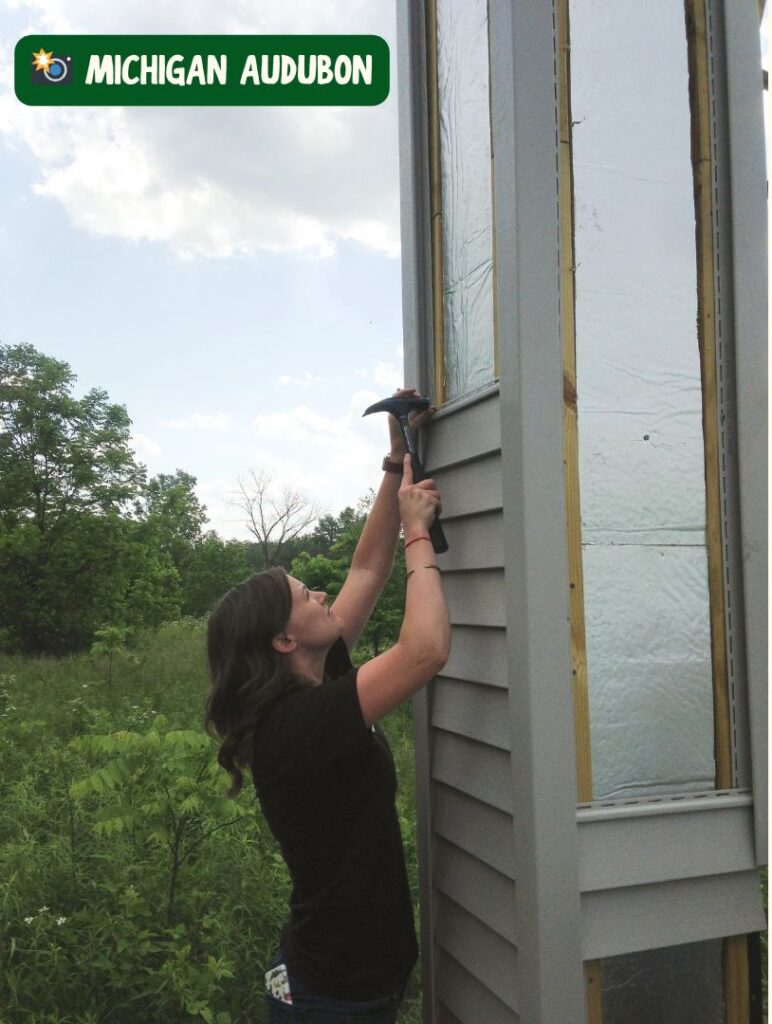
Similar to a bat house, Chimney Swift towers are a naturalistic substitute for traditional nesting structures. This is something we hope to construct at RWS in the near future, when funding and time permit. (You can donate to RWS and support our Sanctuary’s Chimney Swift tower goal!)
There are many ways to build your own tower! This manual by Paul and Georgean Kyle, founders of the Chimney Swift Conservation Association, provides an extremely detailed break-down of their proven process. Their website has some helpful videos, as well. The Western Pennsylvania Audubon chapter also has an excellent guide, available here.
With your help, we can keep these little rockstar birds soaring and chittering for decades to come. 🤘👩🎤
Thank you for reading this month’s Critter Corner!
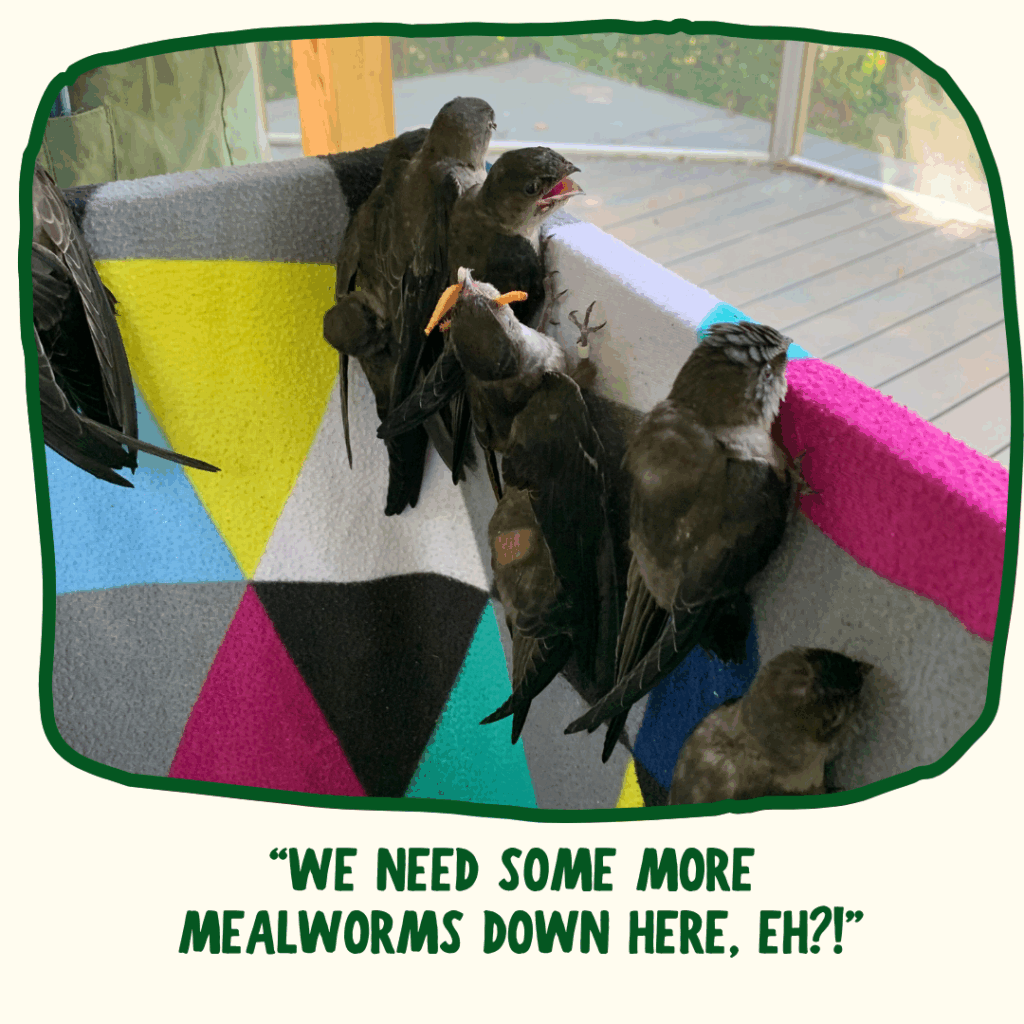
August 1, 2025
Published:
Be the first to comment!